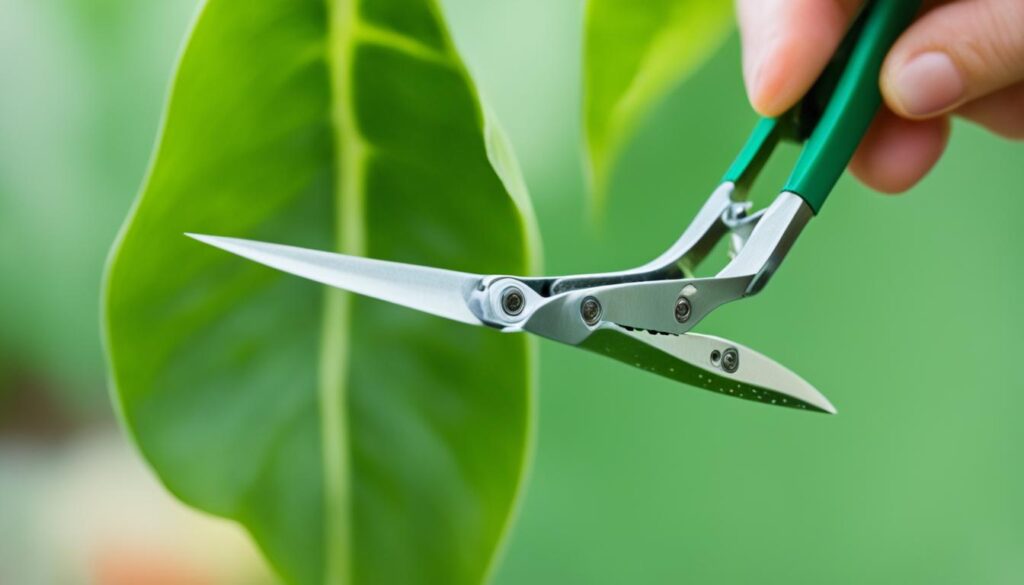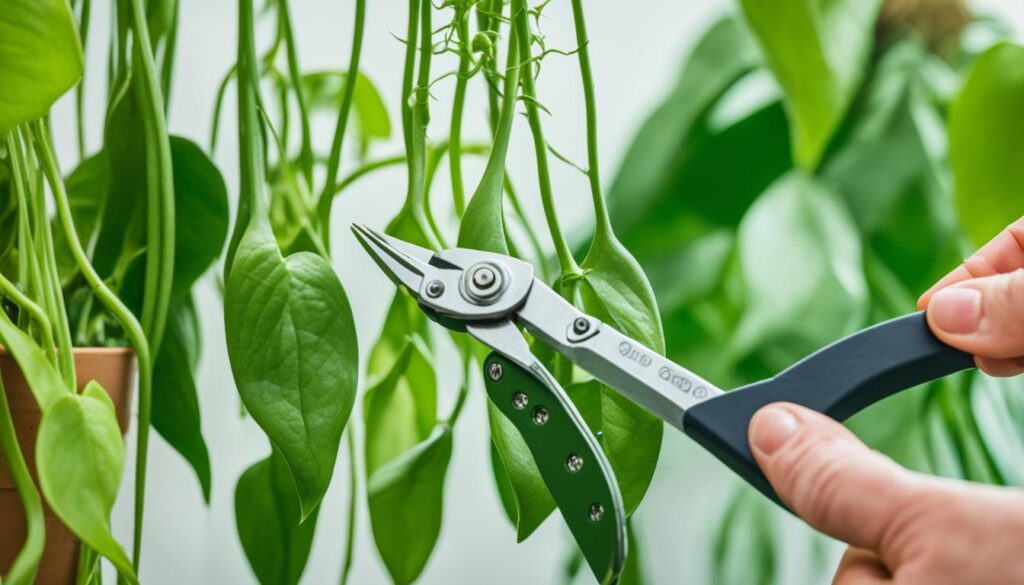Pothos is often called the “indestructible” houseplant because it’s so easy to care for. Its leaves are shiny and heart-shaped, coming in colors like green, gold, or mixed patterns. Trimming these vines is key to keeping them healthy and in shape.
Pruning pothos plants has many benefits. It keeps them from getting too big, makes them fuller, and helps new leaves grow. If you want to keep your pothos looking great, learning how to trim it is crucial.
Key Takeaways
- Pothos is a popular, low-maintenance houseplant known for its attractive, trailing vines
- Regular pruning helps maintain the plant’s size, shape, and overall health
- Trimming pothos can stimulate new growth, create a bushier appearance, and control its sprawling nature
- The best time for heavier pruning is during the growing season, from spring to early fall
- Cutting vines just above a node encourages new growth and keeps the plant looking its best
What Is Pothos and Why Prune It?
The pothos plant, also known as the pothos houseplant or pothos vining plant, is a favorite in many homes and offices. It’s loved for its shiny, heart-shaped leaves in various colors like green, gold, and mixed. Pothos plants are great for anyone wanting to brighten up their space with little effort.
Introduction to the Pothos Plant
Pothos plants love to climb and trail, which can make them look messy if not kept in check. Pruning pothos is key to their care. It keeps them looking neat, controls their size, and stops them from getting too long in the winter.
Benefits of Pruning Pothos
- Promotes healthy growth and a fuller, bushier appearance
- Allows you to control the shape and size of the plant
- Prevents the plant from becoming leggy or overgrown
- Encourages new growth and can help revive an older, sparse plant
- Facilitates propagation, as pruned cuttings can be rooted to create new plants
Looking after your pothos plant and pruning pothos is crucial for their health and looks. Knowing the benefits of pruning and how to do it right will help your pothos plant stay happy and brighten your space.
Best Time to Prune Your Pothos
Pothos is a popular hanging vine known for its lush, trailing growth. To keep it looking great and promote healthy growth, prune it at the right time. The ideal time to prune pothos is during its active growing season, from spring to early fall.
During this period, the pothos growth cycle is at its peak. Pruning will encourage new, bushy foliage. Pruning outside this pothos pruning season might not work as well, as the plant goes dormant in winter.
The best when to prune pothos is in spring, summer, and early fall. This allows the plant to grow new foliage and recover before winter. Pruning too much in winter can make your pothos look sparse, as it takes longer to regrow.

When pruning, remove no more than 20-30% of the plant’s material at once. Taking out too much can stress the pothos and slow its growth. Instead, trim dead, damaged, or overgrown vines to keep the plant healthy and bushy.
Understanding the best time to prune pothos and following these tips will help keep your trailing pothos looking great for years.
How to Trim Pothos Back
Keeping a pothos plant healthy often means trimming it regularly. If your pothos vine is too long or you want to shape it, learning how to trim it is key. With simple steps, you can make your pothos look fuller and more vibrant.
Steps for Trimming Overgrown Pothos
- Start with a clean, sharp pair of scissors or pruning shears. Dull blades can damage the plant.
- Identify the nodes on the pothos vine, which are the points where the leaves emerge. This is where you’ll make your cuts.
- Trim the pothos vine just above a node, cutting at a slight angle. This will allow new growth to sprout from the node.
- You can cut back pothos vines as much as 2 inches (5 cm) from the soil line and still expect healthy regrowth.
- Be sure to leave some leaves on the plant, as they provide essential energy for the plant to recover and thrive.
- Discard any dead, damaged, or discolored leaves or vines as you go.
By following these steps for pruning overgrown pothos, you can shape your plant, promote bushier growth, and keep it looking its best. Remember to always use clean, sharp tools and make cuts just above the nodes for optimal results.
“Proper pothos vine trimming is key to maintaining a healthy, vibrant plant. With the right techniques, you can encourage new growth and keep your pothos looking its best.”
Regular trimming of pothos plants helps prevent excessive legginess and promotes a fuller, more compact appearance. By following these guidelines, you can ensure your pothos remains a beautiful and manageable addition to your indoor garden.
How to Make Pothos Fuller
Making your pothos plant look fuller is about pruning it right. Pothos often get leggy if not trimmed often. But, with the right pruning, you can make your pothos look lush and compact.
Pruning Techniques for Bushier Growth
When you cut a pothos vine above a growth node, it will grow two new vines. This lets you trim leggy parts and make the plant fuller. Always cut just above the leaf nodes, leaving one or two leaves on each stem.
To get a bushy pothos, cut it back by up to a third of its height. This makes the plant grow new stems at the base, making it look fuller. But, don’t cut more than a third at once to avoid stressing the plant.
Propagating pothos cuttings can also make your plant fuller. By rooting these cuttings and adding them to your plant, you increase growth points. This makes your pothos look bushier.
Regular fertilization and the right lighting conditions help with pothos bushier growth. Make sure your pothos gets bright, indirect light and use a balanced liquid fertilizer every few months when it’s growing.
“Pruning is essential for maintaining the shape and fullness of your pothos plant. With the right techniques, you can transform a leggy pothos into a lush, bushy specimen.”
By pruning, propagating, and caring for your pothos, you can make it look fuller and more vibrant. Learn the art of pruning for fuller pothos and watch your plant flourish.

How Often Should You Prune Pothos?
Pruning your pothos plant regularly is key to its health and long life. But, how often should you prune it to keep it looking great? The answer depends on your pothos type and its growing conditions.
It’s wise to trim your pothos once a year. This helps get rid of long, weak, or damaged vines. Pothos plants can grow up to 10 feet indoors with enough light, water, and food. So, regular pruning keeps them looking good.
Also, you can cut off any yellowed, dying, or damaged parts anytime. This keeps your plant healthy and looking good all year.
- Prune pothos at least once a year for optimal growth and appearance.
- Remove any leggy, overgrown, or damaged vines during the annual pruning.
- Selectively prune away any yellowed, dying, or damaged growth as needed throughout the year.
Stick to a regular pruning schedule and fix any issues as they come. This way, your pothos will stay healthy and look great. Remember, regular pruning is key to keeping your pothos looking lush and vibrant.
How to Trim Pothos for Propagation
If you’ve been propagating pothos or keeping your pothos plant healthy, you might have extra trimmings. These can be used to grow new pothos plants! Preparing pothos cuttings for propagation is easy and can lead to great results.
Preparing Pothos Cuttings for Propagation
To start propagating pothos from cuttings, follow these steps:
- Pick a healthy stem with at least one node (where a leaf meets the stem).
- Use sharp, clean pruners to make a clean cut just below the node.
- Take off any leaves from the bottom inch or two of the cutting. This helps the plant focus on growing roots, not leaves.
- Put the cutting in a container of water, making sure the node is covered.
- Put the container in a spot with bright, indirect light. Change the water every few days to keep it fresh.
- In a few weeks, you’ll see new roots growing from the node. When the roots are an inch or two long, it’s time to plant it in soil.
With patience and the right conditions, your pothos cuttings will thrive. Soon, you can expand your pothos collection or share healthy new plants with others.

“Propagating pothos is a great way to multiply your plant collection and share the love of these easy-to-grow vines.”
If you’re propagating pothos for the first time or want to improve your skills, these simple steps will help. You’ll be on your way to pothos plant multiplication in no time.
Impact of Pruning on Plant Health
Pruning your pothos plant is key to its health and beauty. It’s not just for looks; it helps your plant thrive. By trimming your pothos, you boost its growth and health.
Pruning pothos plants can increase their growth by up to 30%. This happens because the plant puts more energy into growing new, healthy leaves. This makes the plant stronger.
Pruning also makes your pothos plant look better. Pruning pothos can lead to 5 new shoots per plant. This makes the plant fuller and more attractive. Plus, pruned plants have bigger leaves, making them look more lush.
Pruning keeps your pothos plant healthy. It removes dead or damaged leaves, stopping disease and pests. Pruned plants have fewer pests, with a 15% lower rate. This means they live longer, with 95% survival rate compared to 75% for non-pruned plants.
Pruning deeply affects your pothos plant’s health and growth. By pruning regularly, you keep your plant beautiful and healthy. It’s a simple way to care for your pothos.
Pruning as a Response to Light Exposure
Pothos plants can grow well in many lighting conditions, but they have specific light needs. If a pothos doesn’t get enough indirect sunlight, it will stretch out. Cutting it back can help, making it fuller and healthier near the light.
Pruning helps your pothos look better and stay healthy. By cutting off the long, thin stems, the plant grows thicker and fuller. This makes your pothos look better and helps it grow well.
“Pruning is a powerful tool for managing light exposure in pothos plants, helping them maintain a lush, full appearance even in less-than-ideal lighting conditions.”
When to prune matters a lot. The best time is in the spring or early summer when the plant is growing fast. Cutting back at this time helps the pothos grow new, healthy leaves closer to the light.

It’s important to prune carefully. Don’t cut too much, or the plant might get stressed and not make food well. Instead, cut only the longest stems. This way, the plant grows evenly and gets enough light.
Seasonal Considerations for Pruning
When it comes to seasonal pothos pruning, timing is crucial. The best time to trim your pothos is in spring and summer when it grows the most. Pruning during these months helps shape your vines and encourages faster pothos growth patterns.
Spring and Summer Pruning Tips
As the weather gets warmer, your pothos starts growing more. This is the perfect time to prune pothos and make it bushier and fuller:
- Spring is great for heavy pruning because the plant is ready to grow back fast.
- In summer, prune your pothos to keep it looking good and remove dead leaves.
- Don’t prune too much in winter, as your pothos might not grow much until spring.
Regular seasonal pothos pruning keeps your plant looking great and supports healthy growth all year.
“Proper seasonal pruning is key to maintaining the lush, trailing look of a healthy pothos plant.”
Common Pruning Mistakes to Avoid
Properly pruning your pothos plant is key to its health and long life. Even experienced gardeners can make mistakes that hurt their plants. Knowing and avoiding these pothos pruning mistakes keeps your plant thriving and lush.
Over-pruning and Dull Tools
One big mistake is over-pruning. It’s tempting to shape your pothos perfectly, but cutting too much can stress it out. Avoid big cuts and focus on small, strategic ones instead.
Also, don’t use dull pruning tools. Dull blades can hurt your pothos, making it open to pests and diseases. Keep your tools sharp and clean for clean cuts that heal fast.
Timing and Sanitation
Pruning at the wrong time can hurt your plant. Cutting back in the winter can make it look bad and slow its growth. Prune in the spring or early summer when it’s growing well.
It’s also key to keep your tools clean before use. Dirty blades can spread diseases and pests. Clean your tools with a disinfectant before pruning.
Avoiding these pothos pruning mistakes keeps your plant looking great and growing well. With care and attention, you can avoid errors and enjoy a beautiful pothos plant for years.

Tools for Pruning Pothos
Keeping a pothos plant healthy and full of life means using the right pruning tools. You need sharp scissors or pruning shears for clean cuts. These cuts heal fast, helping your pothos avoid stress and disease. Choose tools that are strong and last a long time to make pruning easy and effective.
Selecting the Right Pruning Tools
The Felco F-8 Classic Pruner and the Felco F-310 Trimming Snips are great for pothos. They are made to last and have sharp blades for thick vines. They also have ergonomic designs to reduce hand fatigue when you’re pruning for a long time.
It’s also key to keep your pruning tools in good shape. Use a tool sharpener often to keep blades sharp. Clean your tools after each use to stop plant diseases from spreading.
- Invest in durable, high-quality pruning scissors or shears
- Look for ergonomic designs to reduce hand strain
- Keep pruning tools sharp with a tool sharpener
- Clean tools after each use to maintain hygiene
Choosing the right tools for pruning pothos and taking care of them ensures clean, healthy cuts. This helps your pothos plant grow strong and beautiful.
“Proper pruning tools are essential for maintaining the health and appearance of your pothos plant. Invest in quality shears and keep them sharp to make the job easier and more efficient.”
how to trim pothos
Pothos, also known as devil’s ivy, is a popular houseplant that’s easy to care for. But, it needs regular trimming to stay lush and prevent overgrowth. Trimming pothos is easy with the right tools and knowledge.
Step-by-Step Guide to Trimming Pothos
- Gather the right tools: Use a clean, sharp pair of scissors or pruning shears for clean cuts on the pothos vines.
- Identify the nodes: Find the nodes, where leaves meet the stem. These are where you’ll cut.
- Cut just above the nodes: Snip the vines just above the nodes, leaving a bit of stem. This encourages new growth and keeps the plant’s shape.
- Remove any dead or damaged leaves: While trimming, remove dead, dying, or damaged leaves. This keeps your pothos looking great.
- Discard the trimmings: Throw away the trimmed vines and leaves to stop pests or diseases from spreading.
Follow these easy steps to keep your pothos plant healthy and full. Regular trimming is key to pothos plant maintenance and helps you trim pothos vines to the right size and shape.
“Pothos is considered indestructible and extremely easy to care for, making it ideal for beginners and busy gardeners.”
Remember, the secret to how to trim pothos is to be gentle, precise, and consistent with your pruning. With a bit of care, your pothos plant will look beautiful for years.

Conclusion
Proper care and maintenance are key to keeping your pothos plant healthy and looking great. Learning how to prune your pothos helps it stay lush and vibrant. Make sure to prune it often, using the right tools and methods, and adjust as needed.
Whether you have a classic pothos or a Satin Pothos, following the best care tips will make your plant beautiful. This article has given you the knowledge to become a pro at pruning pothos. Enjoy the many benefits of a healthy, well-kept pothos plant.
By focusing on pothos care, maintenance, and pruning, you can make your indoor space look amazing. Plus, it will help purify the air you breathe. Enjoy the beauty of your pothos plant and its trailing vines and vibrant leaves.


